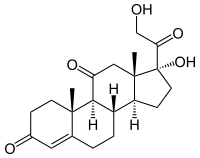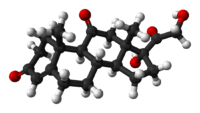Cortisone facts for kids
Quick facts for kids Cortisone |
|
|---|---|
 |
|
 |
|
| IUPAC name | (8S,9S,10R,13S,14S,17R)-17-Hydroxy-17-(2-hydroxyacetyl)-10,13-dimethyl-1,2,6,7,8,9,12,14,15,16-decahydrocyclopenta[a]phenanthrene-3,11-dione |
| Other names | 17α,21-Dihydroxypregn-4-ene-3,11,20-trione; 17α,21-Dihydroxy-11-ketoprogesterone; 17α-Hydroxy-11-dehydrocorticosterone |
| Identifiers | |
| CAS number | |
| PubChem | |
| KEGG | D07749 |
| MeSH | |
| ChEBI | CHEBI:16962 |
| SMILES | O=C(CO)[C@@]3(O)CC[C@H]2[C@@H]4CC\C1=C\C(=O)CC[C@]1(C)[C@H]4C(=O)C[C@@]23C |
|
InChI
InChI=1/C21H28O5/c1-19-7-5-13(23)9-12(19)3-4-14-15-6-8-21(26,17(25)11-22)20(15,2)10-16(24)18(14)19/h9,14-15,18,22,26H,3-8,10-11H2,1-2H3/t14-,15-,18+,19-,20-,21-/m0/s1
|
|
| Properties | |
| Molecular formula | C21H28O5 |
| Molar mass | 360.42 g mol-1 |
| Melting point |
220 to 224 °C, Expression error: Unrecognized word "to". K, Expression error: Unrecognized word "to". °F |
| Pharmacology | |
| ATC code | |
| Except where noted otherwise, data are given for materials in their standard state (at 25 °C, 100 kPa) | |
Cortisone is a 21-carbon steroid hormone. Its chemical name is 17-hydroxy-11-dehydrocorticosterone. It is one of the main hormones released by the adrenal gland in response to stress.
In chemical structure, it is closely related to cortisol. It is used to treat a variety of ailments and can be administered in various ways. Cortisone suppresses the immune system. This reduces inflammation, pain and swelling at the site of the injury. Long-term use of cortisone has risks.
Tadeus Reichstein, E.C. Kendall and P.S. Hench were awarded the Nobel Prize in Physiology or Medicine in 1950 for their discovery of cortisone.
See also
 In Spanish: Cortisona para niños
In Spanish: Cortisona para niños

